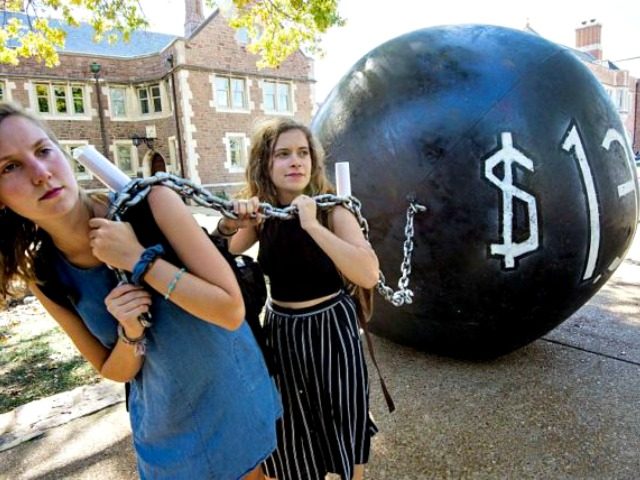The student loan debt in the United States stands at $1.7 trillion, with the average individual obligation at more than $29,000 and only a slight majority making progress on their balance due.
A report from the credit-rating agency Moody’s Investors Service was released late last week on its subscription-only website, CNN reported.
“Over the next few years, the combination of slow repayments and elevated, if no longer growing, levels of new borrowing will likely fuel further increases in outstanding debt,” the report authors wrote.
The only good news in the report is that the number of students enrolling in higher education has declined, meaning less are incurring debt, and college tuitions have stabilized in relation to college enrollees’ incomes, Moody reported.
But borrowers are slow in paying back existing loans, which means their balances will continue to grow, CNN reported:
Over the past decade, the aggregate annual net student loan repayment rate — meaning the amount of existing balances eliminated each year — has averaged about 3 percent, according to the Moody’s report.
Only 51 percent of federal borrowers who were scheduled to start paying back their loans in 2010 to 2012 had made any progress after five years, the report said. Students who attended all types of institutions have struggled with loan payments, although people who attended for-profit or two-year institutions have had a particularly tough time. Many of them haven’t paid down their balances at all.
There are several reasons that people have been slow to repay their student loans. For one, the job prospects for many graduates of for-profit, two-year and non-selective four-year schools aren’t great, making it hard to earn the income needed to pay back loans and otherwise stay afloat. Some students don’t complete their programs or receive degrees. Another reason that Moody’s cites for slow repayment is a rise in income-driven repayment plans, which can lower monthly loan payments based on their incomes and the size of their families and make paying back those loans more affordable.
“As you can imagine, the monthly payment will be lowered to reduce their monthly obligation but at the same time that keeps the loan outstanding for much longer and the repayment rate is going to be much slower,” Nicky Dang, senior vice president/manager at Moody’s, told CNN.
The Moody report said only about a quarter of loan balances are being repaid on ten-year or shorter terms, and people who are choosing to make smaller payments for longer loan terms may be doing it out of necessity or choice, Warren Kornfeld, senior vice president at Moody’s told CNN.
Student debt is the fastest growing type of U.S. debt in the last decade, second only to home mortgages, according to Moody’s.
CNN reported:
About two in three college seniors who graduated from public and private nonprofit colleges in 2018 had student debt, according to the most recent data from the Institute for College Access and Success. Those borrowers owed an average of $29,200.
Student loan debt is “weighing on household finances and the broader economy,” according to Moody’s.
“Having student loan debt affects whether a person can access other forms of household credit, including whether they are able to save for a down payment on a home, qualify for a mortgage or start a small business — all of which drive economic growth and wealth creation,” CNN reported.
Follow Penny Starr on Twitter

COMMENTS
Please let us know if you're having issues with commenting.